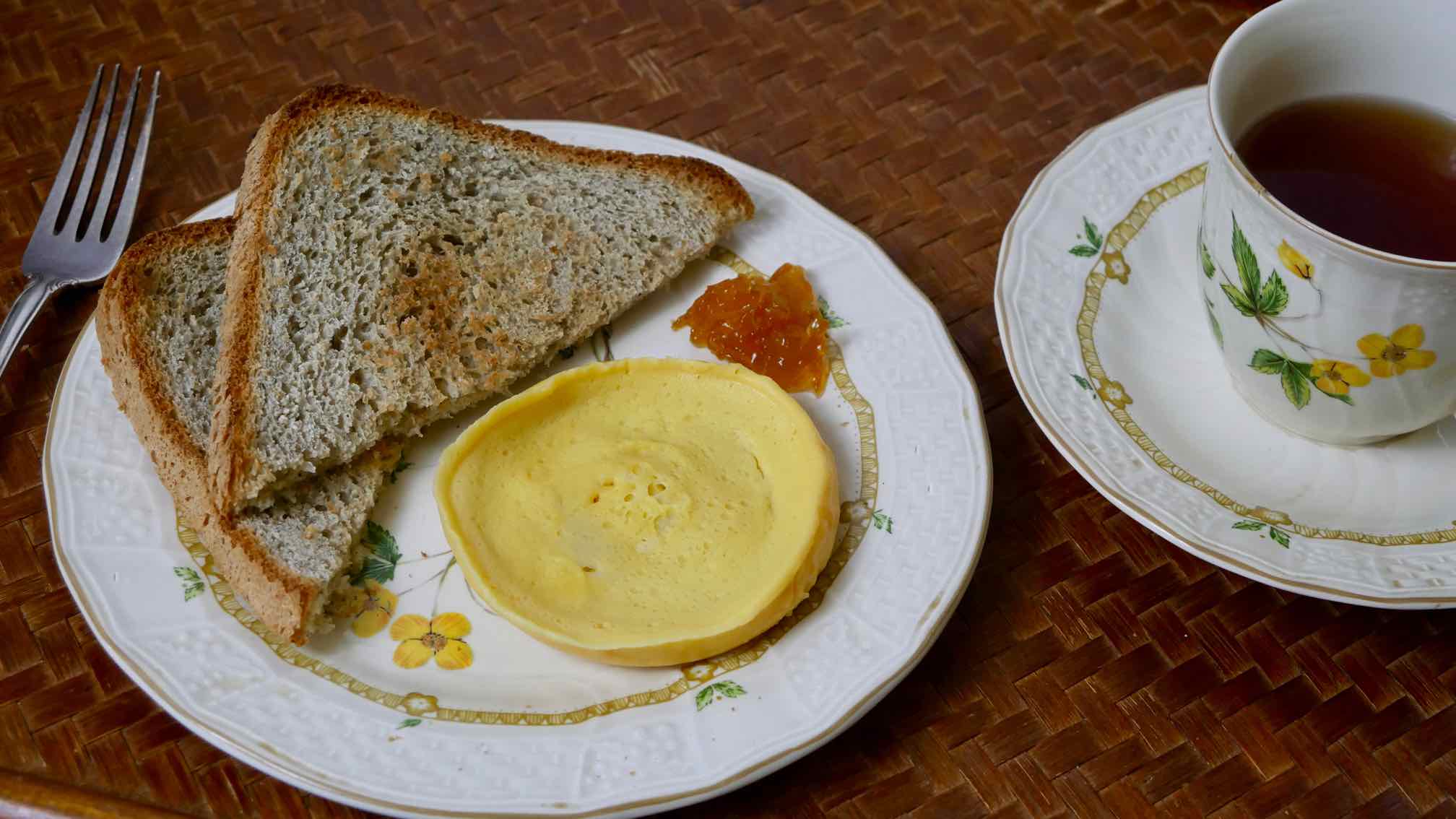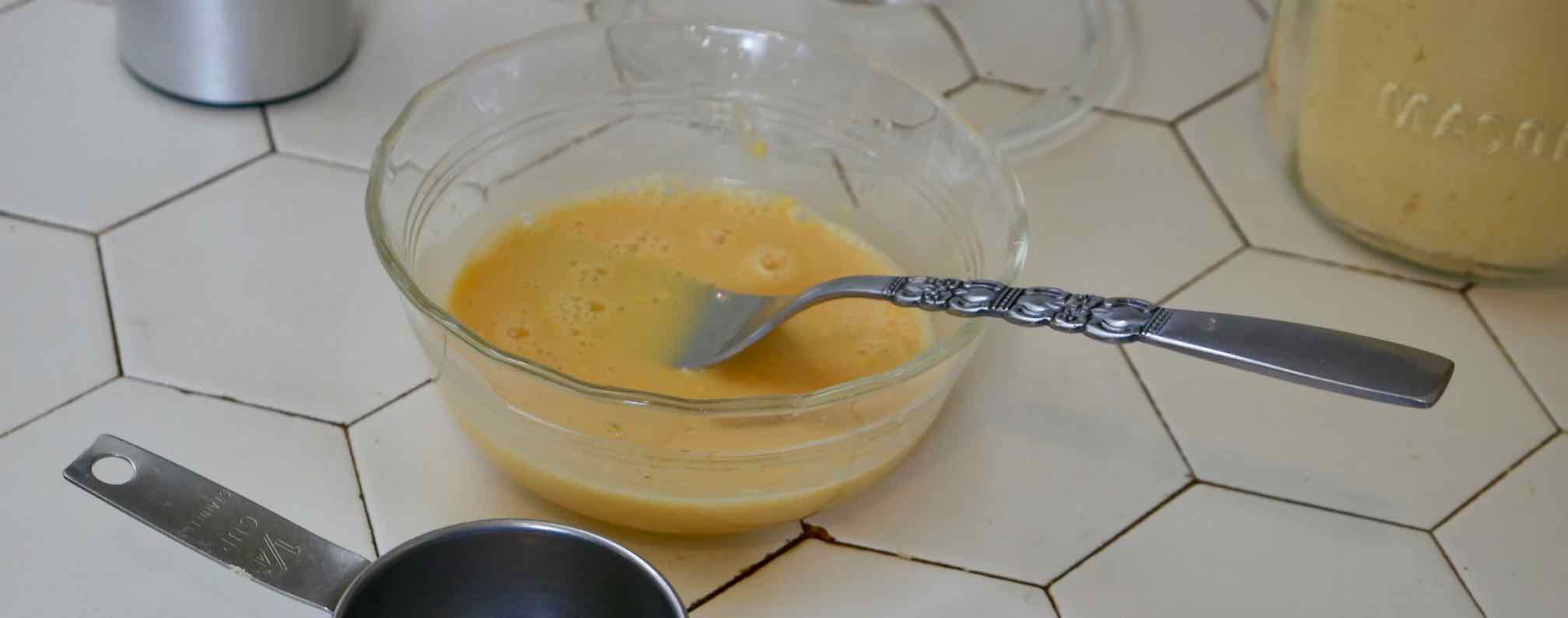annebarone.com
French Chic & Slim
Nouvelles
News and Opinion from Anne Barone to Keep You Chic & Slim — INDEX to Previous Nouvelles
excellent source COVID-19 information: Bing Covid-19

image: breakfast egg from dried eggs cooked in microwave with whole wheat buckwheat toast, kumquat marmalade, and tea
|| 20 July 2020 — UPDATED 21 July 2020
Anne’s Best Way To Cook Powdered Eggs
Note: Article now updated with photos of equipment and cooked egg
Using dried powdered eggs in baking is actually easier than using fresh eggs. No egg shells to crack and discard. Just mix the dried egg powder with other dry ingredients and mix the appropriate amount of water with the liquid ingredients.
Making an omelette, or just trying to cook one egg for breakfast, is another matter.
I have given up trying to cook these dried eggs in a pan. No matter what I do, I get a rubbery yellow substance much of which is stuck to the pan.
But I have found a way to cook powdered dried eggs that produces a breakfast egg or a nice little omelette with less work — and much less waste and cleanup — than the pan method.
To cook the equivalent of one egg, I use a small, oven-safe glass 1-cup covered baking dish that originally belonged to my great aunt. She would often bake an egg in her kitchen range oven for her lunch using this little dish. I, of course, use my microwave.

image: measuring dried egg powder into baking dish
Some of the same problems cooking fresh eggs in a microwave are also problems in cooking rehydrated powdered eggs. In both cases, you do not want to use full power. For me it works best if I cook in a covered microwave-safe dish at 70% power.
Here is how I make a 1-egg mini-omelette with dried powdered eggs.
First I spray or rub the inside of the baking dish with oil. I use olive oil.
Rehydration instructions for my brand of powdered eggs is 2 tablespoons egg powder mixed with 4 tablespoons (1/4 cup) water.
So I put 2 tablespoons powdered eggs into the dish. When measuring, I am careful to pack the powdered eggs in the measuring spoon — the way you would pack brown sugar to measure it.
Gradually I add 1/4 cup water (at room temperature) to the dry egg powder, beating in the water with a fork, avoiding touching the oiled sides of the dish with the fork.
Small lumps of powder are not a problem. I allow the egg powder and water mixture to stand for 3 to 5 minutes. This will soften the lumps enough that they will cook into the mixture.

image: mixing dried egg powder with water
After the standing time, I beat the egg and water mixture with a fork for about 15 additional seconds. Then, I cover the dish and set it in the microwave.
Microwaves vary so much in power that you have to experiment with the best cooking time for your appliance. Ten seconds can make a big difference cooking 1 egg.
In my microwave, I cook the egg mixture 55 seconds on 70% power. If the omelette is not completely cooked, I carefully turn it over using a fork, cover the dish and cook an additional 10 seconds, again at 70% power. Let stand covered at least 1 minute. Voilà ! A lovely little mini-omelette.
To make a two-egg luncheon omelette, I use 1/4 cup egg powder and 1/2 cup water and cook in a covered 2-cup microwave-safe dish. The 2-egg omelette will usually require 55 seconds on 70% power, a turn over, then about 20 seconds on 70% power — and the 1 to 2 minutes standing time.
As for taste, the dried eggs produce a somewhat different taste than that of fresh eggs — but one that I have come to enjoy. And I love the texture of these dried eggs cooked by my microwave method. I do variations: sometimes adding bacon crumbles or shredded cheese for the second part of the cooking. Or I make a traditional omelette aux fine herbs adding a little dried parsley, chives and chervil.
be chic, stay slim — Anne Barone